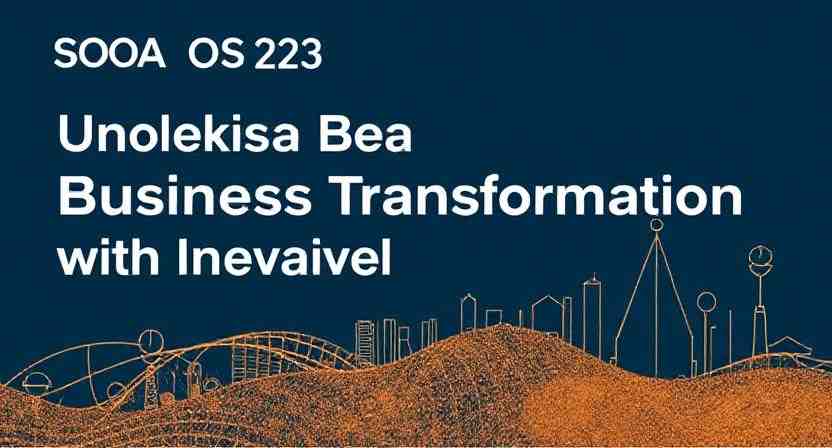In today’s fast-paced digital landscape, businesses are constantly seeking ways to streamline operations, improve efficiency, and stay ahead of the competition. One of the most promising developments in recent years is the emergence of comprehensive software solutions that cater to diverse business needs. Among these, SOA OS23 stands out as a transformative platform that empowers organizations to optimize their workflows, enhance scalability, and foster innovation. This article explores the intricacies of SOA OS23, its benefits, and how it can revolutionize your business operations. Whether you’re a startup or a multinational corporation, understanding the potential of SOA OS23 can help you make informed decisions for sustainable growth.
What Is SOA OS23? An Overview of Its Core Features
SOA OS23 is a cutting-edge service-oriented architecture (SOA) platform designed to facilitate seamless integration and interoperability among various business applications. Built with versatility and scalability in mind, SOA OS23 enables organizations to create a flexible IT ecosystem that adapts to evolving market demands. Its core features include modular components, robust security protocols, and extensive API capabilities that allow businesses to connect disparate systems effortlessly. By leveraging SOA OS23, companies can break down silos, promote reusability of services, and accelerate digital transformation initiatives. This platform acts as the backbone of modern enterprise architecture, providing a unified framework for managing complex business processes efficiently.
Why Choose SOA OS23 for Your Business? Benefits That Make a Difference
Adopting SOA OS23 offers numerous advantages that can significantly impact your business’s success. Firstly, it enhances operational agility by enabling rapid deployment of new services and features, reducing time-to-market. Its modular design promotes scalability, allowing organizations to expand their systems without extensive overhauls. Additionally, SOA OS23 improves resource utilization by reusing existing services, which cuts costs and minimizes redundancy. Security is another critical aspect, as the platform incorporates advanced authentication and authorization mechanisms to protect sensitive data. Furthermore, the platform’s interoperability ensures seamless communication across diverse applications and platforms, fostering a more integrated and efficient business environment. Ultimately, SOA OS23 empowers businesses to innovate faster, respond promptly to market changes, and deliver superior customer experiences.
Implementing SOA OS23: Step-by-Step Guide for Success
Implementing SOA OS23 requires careful planning and execution to maximize its benefits. The first step involves conducting a thorough assessment of your existing IT infrastructure to identify integration points and potential gaps. Next, define clear objectives and outline the scope of the implementation, aligning it with your strategic goals. Engaging stakeholders from different departments ensures buy-in and facilitates smoother adoption. During the development phase, leverage the platform’s modular architecture to build reusable services tailored to your business needs. Testing is crucial to identify and resolve any issues before deployment. Once implemented, provide comprehensive training to your team to ensure they understand how to utilize the platform effectively. Continuous monitoring and iterative improvements will help optimize performance and adapt to evolving requirements, making SOA OS23 a valuable long-term asset.
Key Challenges and Solutions When Deploying SOA OS23
While SOA OS23 offers significant benefits, deploying it can present certain challenges that organizations must address proactively. One common obstacle is resistance to change, as staff may be accustomed to legacy systems. To overcome this, invest in thorough training and communicate the strategic advantages of adopting SOA OS23. Another challenge is integrating existing applications with the new platform, which can be complex if systems are outdated or poorly documented. Solutions include conducting detailed integration planning and utilizing middleware tools that facilitate smooth connectivity. Security concerns also arise, especially when exposing services over networks; implementing robust security protocols and adhering to best practices mitigate these risks. Additionally, managing the complexity of service dependencies requires disciplined governance and clear documentation. By anticipating these challenges and applying strategic solutions, organizations can ensure a successful SOA OS23 deployment that delivers long-term value.
Future Trends in Business Technology with SOA OS23
The evolution of SOA OS23 is poised to shape the future of enterprise technology in profound ways. As organizations increasingly adopt cloud computing, SOA OS23’s compatibility with cloud environments allows for flexible, scalable deployments that support remote work and global operations. Artificial Intelligence (AI) integration within SOA OS23 is set to enhance automation, predictive analytics, and decision-making processes, giving businesses a competitive edge. Additionally, the platform’s modular nature aligns well with microservices architecture, enabling even more granular and efficient service management. The rise of the Internet of Things (IoT) also presents new opportunities for SOA OS23 to connect and manage vast arrays of devices, fostering smarter supply chains and customer engagement strategies. As cyber threats evolve, SOA OS23’s security features will continue to advance, ensuring data integrity and compliance. Embracing these trends will position your business for sustained innovation and growth in the digital age.
How SOA OS23 Enhances Customer Experience and Business Agility
Delivering exceptional customer experiences is paramount in today’s competitive market, and SOA OS23 plays a vital role in achieving this goal. By enabling rapid integration of customer-facing applications and backend systems, the platform ensures a seamless and personalized experience across multiple touchpoints. For instance, real-time data sharing between sales, support, and marketing teams allows for more tailored interactions, fostering loyalty and satisfaction. Moreover, SOA OS23’s agility allows businesses to quickly adapt to changing customer preferences, deploy new services, or modify existing ones without disrupting operations. This flexibility ensures your organization remains responsive and innovative, key factors in building a strong brand reputation. Ultimately, SOA OS23 bridges the gap between technology and customer needs, creating a dynamic environment where your business can thrive.
Case Studies: Real-World Success Stories with SOA OS23
Several organizations across various industries have successfully implemented SOA OS23 to transform their operations. For example, a leading retail chain integrated its supply chain, inventory management, and e-commerce platforms using SOA OS23, resulting in faster order processing and improved stock accuracy. This integration enabled real-time updates and reduced delays, significantly enhancing customer satisfaction. In the finance sector, a bank leveraged SOA OS23 to connect legacy systems with modern mobile apps, providing customers with seamless banking experiences and enabling rapid deployment of new financial products. Another success story involves a healthcare provider streamlining patient data management across multiple facilities, improving care coordination and compliance. These case studies demonstrate SOA OS23’s versatility and effectiveness in driving digital transformation, operational excellence, and customer-centric approaches.
Choosing the Right Partner for Implementing SOA OS23
Successful deployment of SOA OS23 depends heavily on selecting the right technology partner or vendor. When evaluating potential partners, consider their experience with enterprise architecture and integration projects, especially within your industry. A reliable partner should offer comprehensive support, including consultation, development, testing, and ongoing maintenance. Their expertise in security protocols and compliance standards is crucial to protect your data and meet regulatory requirements. Additionally, assess their training and change management capabilities to ensure your team can adopt the platform smoothly. Transparent communication, proven track records, and customer references are valuable indicators of a partner’s reliability. Partnering with an experienced provider ensures your SOA OS23 implementation aligns with best practices, minimizes risks, and delivers maximum value, enabling your business to thrive in a competitive environment.
Conclusion: Embrace SOA OS23 for a Future-Ready Business
As the digital landscape continues to evolve at a rapid pace, embracing innovative solutions like SOA OS23 becomes essential for business resilience and growth. This platform offers a strategic advantage by enabling seamless integration, fostering agility, and supporting scalable architecture. By leveraging SOA OS23, organizations can accelerate their digital transformation journeys, enhance operational efficiency, and deliver superior customer experiences. As future trends point toward increased cloud adoption, AI integration, and IoT connectivity, SOA OS23 stands out as a versatile backbone capable of supporting these advancements. To stay ahead in an increasingly competitive world, investing in the right technology and partnerships now can make all the difference. Make SOA OS23 a cornerstone of your business strategy and position your organization for a future of innovation and success.



